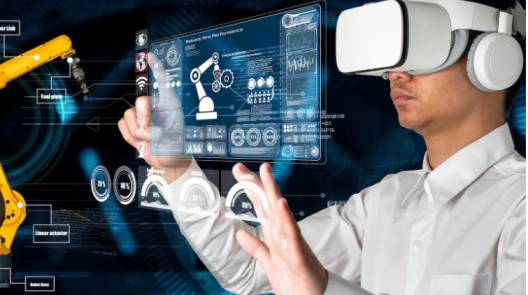
Augmented Reality (AR) is increasingly being integrated into various business operations to enhance user experience, increase customer engagement, and improve operational efficiency. Businesses across different sectors are utilising AR technology for a variety of purposes, such as improving brand awareness, showcasing product demos, increasing customer experience, and streamlining workflows.
Applications of AR in Business are as follows:
- Marketing and Sales: AR can be used to create engaging and interactive marketing campaigns, allowing customers to preview products in their environment before making a purchase. This can lead to increased customer satisfaction and sales.
- Training and Education: AR can create immersive training experiences, allowing employees to learn new skills more engagingly and interactively. This can lead to improved employee performance and reduced training costs.
- Customer Service: AR can be used to provide customers with real-time support and assistance, improving customer satisfaction and reducing the need for in-person service.
- Product Development: AR can be used in the design and development process, allowing designers to visualise and interact with 3D models of products before they are manufactured.
Challenges and Considerations while implementing AR in Businesses are:
- Cost: Implementing AR can be expensive, and businesses need to consider the return on investment before deciding to adopt the technology.
- Technical Expertise: AR requires a certain level of technical expertise to implement and maintain, and businesses may need to invest in training or hiring new staff to ensure successful implementation.
- User Adoption: AR requires users to have access to the necessary technology, such as smartphones or AR headsets, and businesses need to consider whether their target audience is ready for this technology.

How to start AR in your business?
Augmented reality (AR) presents exciting opportunities for businesses looking to enhance customer experiences, improve employee training, and streamline operations. To get started with AR in your business, it is essential to begin by defining your objectives and understanding how AR can align with your overall business goals. Consider the specific areas of your business where AR could make a significant impact, such as marketing, sales, training, or customer service.
Once you have identified potential use cases for AR in your business, the next step is to conduct thorough research on available AR technologies and solutions. Evaluate different AR platforms, tools, and providers to find the best fit for your business needs and budget. It is crucial to choose a solution that is user-friendly, scalable, and compatible with your existing systems.
After selecting an AR solution, invest in training for your team to ensure they have the necessary skills to implement and utilise AR effectively. Collaborate with experts or consultants if needed to help you navigate the complexities of integrating AR into your business processes. Additionally, consider creating a pilot project or proof of concept to test the feasibility and impact of AR before scaling up across your organisation.
Communication is key when introducing AR into your business. Communicate the benefits of AR to stakeholders, employees, and customers to generate buy-in and excitement for the technology. Develop a comprehensive implementation plan that outlines timelines, responsibilities, and key performance indicators to track the success of your AR initiatives.
Lastly, continuously monitor and evaluate the performance of your AR projects to identify areas for improvement and optimisation. Collect feedback from users and stakeholders to refine your AR strategies and ensure they align with your business objectives. By staying agile and adaptive in your approach to AR implementation, you can unlock the full potential of this transformative technology in your business.
Measuring the success of AR implementation in business
To measure the success of AR implementation in your business, you need to track various metrics that can help you evaluate the effectiveness of your AR campaigns. Here are some key metrics to consider:
- Reach and impressions: These metrics measure the size and scope of your audience and can help you assess the awareness and visibility of your brand or offer. You can track reach and impressions using various tools like AR platforms, analytics software, or social media insights.
- Engagement and retention: Engagement and retention measure the quality and depth of your audience’s interaction with your AR content. You can track engagement and retention using metrics such as dwell time, session duration, frequency, and completion rate.
- Feedback and satisfaction: Feedback and satisfaction measure your audience’s perception and opinion and can help you improve and optimise your AR content and design. You can collect feedback and satisfaction using methods such as surveys, ratings, reviews, or social media comments.
- Conversion and revenue: Conversion and revenue measure the impact and value of your AR marketing on your bottom line, and can help you evaluate your AR strategy’s return on investment (ROI). You can track conversion and revenue using metrics such as click-through rate, purchase rate, average order value, and customer lifetime value.
- Conversion rate: This metric measures the percentage of users who completed the desired goal, such as making a purchase, after interacting with your AR content. You can track conversion rates using AR platforms, analytics software, or social media insights.

How can AR be used for employee training and development?
Augmented Reality (AR) is a powerful tool that can revolutionise employee training and development within businesses. By deploying AR technology, companies can create immersive and interactive learning experiences for their employees, enhancing engagement, reducing training costs, and improving knowledge retention.
Benefits of Using AR for Employee Training:
- Realistic Learning Environment: AR provides a hands-on learning environment where employees can practice skills and tasks in a safe and controlled setting, enhancing their confidence and competence.
- Personalised Learning: AR enables personalised and adaptive learning experiences tailored to individual needs, allowing employees to learn at their own pace and preferences.
- Increased Engagement: The interactive nature of AR, with its engaging and interactive format, makes training more fun, interactive, and engaging, leading to higher motivation and retention among learners.
- Cost Efficiency: Utilising AR in training programs can significantly reduce costs by eliminating the need for physical materials and tools, providing a cost-effective solution for employee development.
Challenges of Implementing AR in Employee Training:
Despite the numerous benefits of using AR for employee training, some challenges need to be considered:
- Cost and Accessibility: The cost and availability of AR devices and software may pose challenges for some organisations or employees, limiting widespread adoption.
- Quality of Content: Ensuring the technical and pedagogical quality of AR content is crucial to the effectiveness of training programs. Variances in design, development, and delivery can impact the overall learning experience.
- Ethical and Legal Issues: There may be ethical and legal considerations related to privacy, security, and ownership of data generated by AR applications that need to be addressed to ensure compliance with regulations.
Examples of AR Implementation in Employee Training:
- In the manufacturing sector, AR can assist employees in learning how to operate, maintain, and repair complex machinery through step-by-step instructions, diagrams, and animations.
- In healthcare, AR can help employees acquire medical knowledge and skills by simulating realistic scenarios, procedures, and cases to enhance their expertise.
- Retail businesses can use AR to improve customer service and sales skills by creating virtual scenarios that provide practical training opportunities for employees.
By effectively utilising AR technology in employee training programs while addressing associated challenges, businesses can enhance skill development, improve operational efficiency, and stay competitive in today’s dynamic business landscape.

Conclusion: Envisioning a bright future of AR in the business landscape
The future of AR in business transformation is promising, as it has the potential to drive innovation, improve customer experiences, and enhance operational efficiency. By addressing the challenges and considerations associated with AR implementation and using the technology effectively, businesses can stay competitive and thrive in today’s dynamic market landscape. AR has the potential to transform various aspects of business, from marketing and sales to training and customer service. However, businesses need to carefully consider the costs, technical expertise, and user adoption before deciding to adopt this technology. With the right approach, AR can provide businesses with a competitive edge and improve customer satisfaction and engagement.
